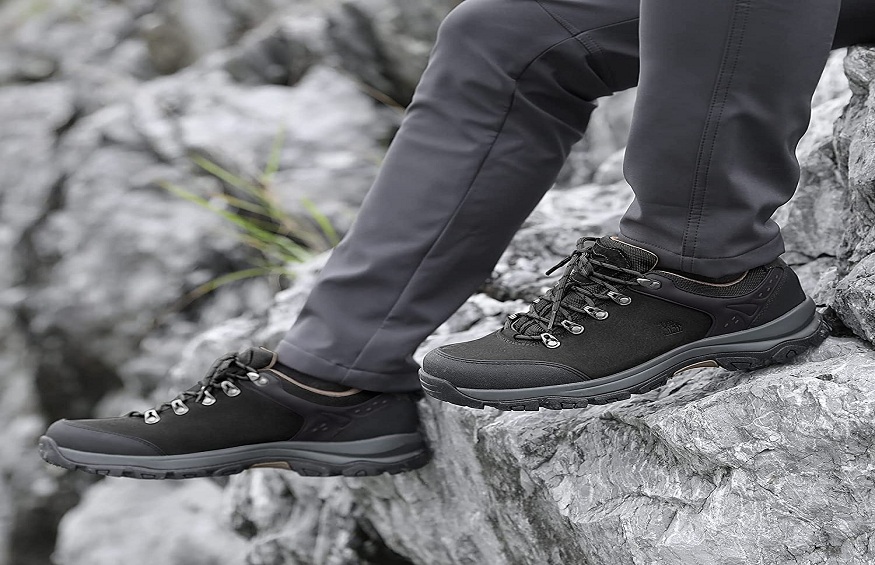If it seems easy to give advice, it is much less so to dispense GOOD advice, that is to say judicious…
Personal experience is certainly undeniable but it can in no way be erected into absolute and universal truth… we do not have the same feet, not the same weight and not the same way of walking… so what is true for me it doesn’t have to be for you…
Our expertise is of course built on our own experience, many paths taken, but much more on the statistical experience of the pilgrims that we have seen pass over the last ten years at the shop, but especially at the lodge: 2000 / year.
1) good thick soles above all
It is first the sole that will make the right walking shoe for THE PATH. Indeed the particularity of the path is that the stages of 20, 25 or 30 km are linked day after day. Unlike a one or two day hike, often on nice trails but not very demanding in terms of feet, if not in terms of elevation and physical effort. On THE WAY, no very big climbs, except at the start of Le Puy or to access Roncesvalles, and later on the approach to O Cebreiro for the Camino Francés. The Camino del Norte is more physical, especially if you take the Primitivo, and the splendid Mozárabe has some nice climbs. On the Way… pebbles, bitumen, climbs, descents, very changing walking rhythms, and this, every day, 10 days, 20 days… And more…
The foot is extremely stressed. If the sole is too light, you will quickly feel it and it will turn into torture to feel the pebbles on a sore sole of the foot…
2) a size and a half more…
At this rate, walking so many kilometers every day, the foot will quickly lengthen and widen. It’s surprising, but it’s also the difference with a one-off hike, especially since there, you have the weight of the bag on your shoulders. So on the feet.
The right measure when trying on shoes is to slide your foot until your toe touches the bottom of the shoe: at this point, you must be able to pass without forcing (too much) your index finger between your heel and the shoe . This is approximately one and a half sizes. One size = 0.5 to 0.7 millimeters, depending on the shoe and the manufacturer… actually it’s not a lot, and it’s always better to have bigger shoes than smaller ones…
3) avoid shoes that are too soft
Of the “running” type: these are made above all for running and not for walking, it is not the same exercise and therefore not the same technology that is used. Of course it’s tempting to have a super light shoe… but you should be able to test them not in a shop on carpet but on 20 km of stony path… There are pilgrims for whom it suits… but statistically it’s the source of the greatest number of problems. Especially since the sole will wear out quickly and the main quality of this type of shoe is not the support of the foot, so we tend to lace it tighter… the foot is quickly compressed, unlike what we need…: comfort! Our toes in the shoe should be able to play the piano…
Many walking shoes are reinforced and have an internal reinforcement at the level of the hollow of the arch of the foot so that the foot is less stressed in flexibility and torsion, unlike a shoe made for running.
4) low or high?
In fact, it is not a high shoe that will prevent you from twisting your ankle. Nor a low shoe, a priori lighter, which will prevent you from tendonitis…
The amount of the shoe is first made to protect the malleoli from possible shocks.
Choose the type of shoes in which you feel most comfortable… the choice is made more in the head than in the feet…
That said, a high shoe will give you a feeling of superior foot support, and that’s normal because the foot is more wrapped. Conversely, a low shoe will give you an impression of greater lightness and better ventilation… that’s also logical.
– For a low shoe: that the heel is maintained and does not come out too much with each step (the heel is less captivating than on a high shoe). That the heel slips slightly… this is normal… since the sole of the shoe is not excessively flexible. It’s like in mechanics… it takes a certain play… let’s say that for us pilgrims… it’s Tolerance…
– For a high-top shoe: that the amount of the shoe does not hinder the flexibility of the ankle when rolling the foot… to give an image: you should not find yourself walking with ski boots… So, do not do not lace the upper part of the shoe hard (except on a rough descent and do not forget to release afterwards).
Note that there are what are called “MID” (average) that is to say semi-rising. The most used shoes on the Way.
In the event of an autumn or winter path, a real high shoe is appreciable in view of the foreseeable bad weather: the foot drier, and above all more suitable for wearing gaiters…
5) length and width of the foot
If it is easy to know your shoe size, transforming it into Cm… is a little more complex… and what interests us is the opposite exercise: transforming the length of the feet expressed in Cm, into shoe size…
In France, the size corresponds to 3/2 of the length of the foot expressed in centimeters, to which we have previously added a centimeter. Thus, a value of 29.3 cm in foot length corresponds to a size of 45. You will therefore choose city shoes in 46 and walking shoes in 46.5 or 47.

